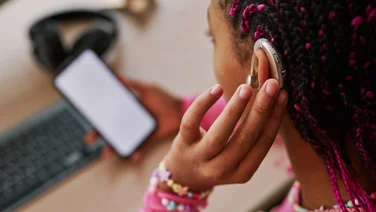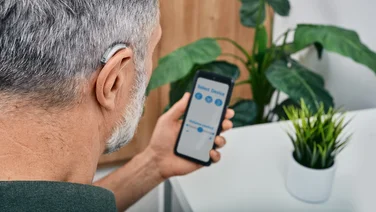To help us provide you with free impartial advice, we may earn a commission if you buy through links on our site. Learn more

Hearing aids are definitely not “one size fits all”. These potentially life-changing devices come in several main types, including behind-the-ear (BTE) and in-the-ear (ITE) styles, and there’s plenty of variety within those key categories. If you’re looking for a device to help you hear better, it’s worth knowing what each type of hearing aid can offer you.
BTE hearing aids are probably the best-known type, but also the most misunderstood, thanks to outdated stereotypes of clunky NHS-issue devices. Today’s lightweight BTE models are packed with sound-enhancing power and digital audio functions, and manufacturers are increasingly delivering advanced functions in smaller and smaller devices, including so-called invisible hearing aids that “disappear” into your ear canal.
In this article we’ll run through the different types of hearing aid, including some newer and lesser-known types as well as the main categories, and explore their pros, cons and main uses. If you have an idea of the ideal type for you, use our free quote finder tool to find a local audiologist so you can chat through your options in person.
Get a free hearing aid quote today
Strapped for time? Take our quick survey below and we’ll match you with a hearing aid provider that suits you.
What are the main types of hearing aid?
There are four main types of digital hearing aid, plus several additional varieties. Here are the big four…
1. Behind-the-ear (BTE) hearing aids

BTE hearing aids, such as the Phonak Audéo Lumity (from £2,295 a pair), are the most common type of hearing aid in the UK. As the name suggests, you wear the main unit (with sound processor, hearing aid chip, controls and so on) behind your ear, but there’s more to the device than that. A piece of clear, flexible tubing goes from the main unit into a plastic ear mould, custom-made for you, which fits inside the shell of your ear. From there, the tubing delivers enhanced sound to your inner ear.
Pros: Their size is the main advantage of BTE hearing aids. It allows hearing aid manufacturers to fit maximum sound-enhancing power into the unit, and numerous functions such as multiple noise environments and rechargeable built-in batteries. This gives you a particularly wide range of models to choose from, to suit different needs and budgets. BTE hearing aids are also easier to remove, adjust and clean than smaller types.
Cons: Again, their size. If you’re self-conscious about your hearing loss and would rather wear a hearing aid that no-one can see, you may decide that a BTE model is too big.
Suitable for: A wide range of hearing levels, including profound hearing loss.
2. In-the-ear (ITE) hearing aids

ITE hearing aids, such as the Signia Active rechargeable instant-fit model (£999 a pair), are smaller than BTE hearing aids, and fit snugly into your ear and ear canal. You can get instant-fit ITE hearing aids that fit like earbuds, but most are custom-moulded to perfectly fill the inner shell of your ear (the concha) and your ear canal. The microphone, amplifier and speaker all fit inside the unit.
Pros: Many wearers say ITE hearing aids are particularly comfortable to wear, especially if you wear glasses. They’re also more discreet than BTE hearing aids, because they can’t be seen from the back, and they’re relatively affordable. They’re big enough to manage easily, and to accommodate advanced audio features and rechargeable built-in batteries.
Cons: The smaller size of ITE hearing aids means they don’t quite pack the sonic power of BTE models, so if you suffer from severe hearing loss they may not be powerful enough to help. And while they’re relatively small, they’re still very visible to other people unless you wear your hair over your ears, so if you’re self-conscious about your hearing loss this is something to bear in mind.
Another potential drawback with all types of hearing aid that completely fill your ear canal is the “blocked” sensation that can make your own voice sound distractingly different, although wearers often find they get used to this in time.
Suitable for: People with mild to moderately severe hearing loss.
READ NEXT: Our guide to in-ear hearing aids
3. In-the-canal (ITC) hearing aids

These hearing aids are similar to ITE models, except that they’re smaller and only fill the opening of your ear canal. In most cases they’re custom-moulded to fit as snugly as possible.
Pros: ITC hearing aids are much less visible than BTE and ITE hearing aids. And because they fit snugly inside the opening of the ear, they tend to give less feedback and whistling than other hearing aid types.
Cons: That snug fit can cause the blocked sensation mentioned above, and the small size of ITC hearing aids can make them a little fiddly to handle if you’re not as dextrous as you used to be.
Suitable for: People with mild to moderate hearing loss.
4. Invisible hearing aids

These are also known as completely-in-the-canal (CIC) hearing aids, because they’re small enough to be completely hidden inside your ear canal.
Pros: CIC hearing aids are the most discreet type of hearing aid. Unless someone is peering right into your ear, they won’t know you’re wearing a hearing aid.
Cons: The tiny size of invisible hearing aids can make them tricky to insert and remove, and also means they don’t have room for as many audio features or as much sound-enhancing power as a bigger hearing aid might offer.
Suitable for: People with mild to moderate hearing loss, and anyone who would prefer to keep their hearing loss hidden.
READ NEXT: Invisible hearing aids explained
What are the other types of hearing aid?
Open-fit BTE hearing aids are BTE hearing aids without the custom-made ear mould that fills your outer ear. The plastic tube, which is almost invisible, fits into a speaker with a soft tip that goes into the opening of your ear canal. They’re a little less visible than standard BTE hearing aids, because they don’t have the large piece of moulded plastic, and they help to cut down on the “blocked” sensation that the mould can create.
Receiver-in-the-ear (RITE) hearing aids are another alternative type of BTE model without the ear-filling mould. The body of the hearing aid sits behind your ear, and the tube attaches to a speaker inside your ear canal opening. They’re ideal for people who want the power of a BTE hearing aid but with a more natural sound and a more discreet appearance, and without completely filling the ear canal.
Bone-anchored hearing aids, also known as bone-conduction hearing aids, attach to implants that are positioned in the bone of your skull just behind one ear (see image below). From there, they transmit sound vibrations to your inner ear, using your body’s natural ability to conduct sound through bone. This delivers clear, natural sound and leaves your ears free of devices, tubes and wires. Bone-anchored hearing aids are ideal for people who suffer frequent ear infections, allergies or other problems with their ear canal, or who have conductive hearing loss that results from a blockage that prevents conventional hearing aids from delivering sound to the inner ear.
READ NEXT: Our guide to bone-anchored hearing aids
CROS/BiCROS hearing aids amplify sound from one ear to the other. You wear the hearing aid on the better hearing side, and a microphone on the poorer hearing side. The acronym stands for “(bilateral) contralateral routing of signals”. These are suitable for people with normal hearing or minimal hearing loss in one ear, and very little or no usable hearing in the other ear.

Which type of hearing aid is easiest to wear?
That depends on what you find comfortable. If you hate the feeling of having your ears blocked, then you’ll find RITE or invisible hearing aids the most comfortable, because they don’t completely block your ear canal. If you dislike wearing anything on the back of your ear or you wear glasses, ITE and other small types of hearing aid may be the most comfortable for you.
The question of individual comfort can really only be answered by visiting an audiologist and trying on a few different hearing aid types for size.
Which type of hearing aid is the most powerful?
BTE hearing aids with a custom ear mould tend to be the most powerful. As well as having room for more circuitry inside, they can also run on a larger 675 battery. We cover batteries in greater detail in our article on hearing aid battery types.
BTE hearing aids also tend to be more versatile for the user, because they have more room for adjustments such as microphone position, and for additional components such as telecoils, which enable wireless connection to phones, TVs and public address systems.
Hearing aid technology is progressing very fast, and many relatively small ITE hearing aids now offer the kind of power and functionality that you could only get in a BTE hearing aid a few years ago. These functions include multiple microphones to improve sound clarity and for easier hearing in noisy environments; multiple program settings for different environments; and noise reduction technology to limit background noise.
READ NEXT: Hearing aid batteries, explained
Which types of hearing aid are rechargeable?
Many models of BTE and ITE hearing aid are available as rechargeable hearing aids. Instead of having a standard disposable battery, they have a battery built in, and you charge your aids by putting them into a charger case. This makes them a great option for people who struggle to replace fiddly disposable batteries, and they’re more environmentally friendly. Rechargeable hearing aids do tend to cost more, but they can save you quite a bit of money on disposale batteries over their lifetime.
READ NEXT: Rechargeable hearing aids – all you need to know
What types of hearing aid can I get on the NHS?
NHS hearing aids are available in a good range of types and makes, including discreet ITE models from top manufacturers such as Phonak and Signia. However, access is more limited than it used to be, and whether you qualify will depend on many factors, including your GP and where you live. You may also find you don’t have a great deal of choice over the make, model or features.
What type of hearing aid is best for me?
The best type of hearing aid for you will depend on your individual needs and preferences. Your audiologist will help you find the best type of hearing aid for you, taking into account your hearing loss, the size of your ear canal, your budget and the types of situation you’ll need your hearing aid for.
To find a local audiologist who can talk through your options with you in person, use our free quote finder tool.






